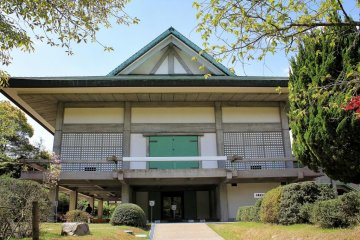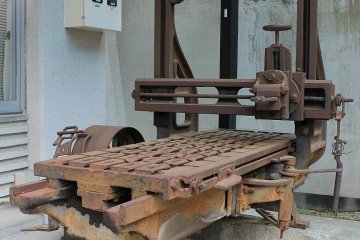As one of the most historically significant shrines in Japan, and beautiful to boot, Oyamazumi Shrine on Omishima Island is worth visiting in its own right. But another reason to visit the shrine is the National Treasure Hall, which holds a fine collection of ancient samurai weaponry and shrine statuary. The 1,000 yen price of admission also includes entry to the adjacent Omishima Maritime Museum.
Located down a gentle slope from the Treasure Hall, the building of the Maritime Museum looks a bit like a concrete tipi. It has a big ship’s propeller in front of it. Omishima is part of Imabari City, and the people of Imabari are fond of displaying their propellers. In the porch to the museum are some industrial machines that don’t have much to do with the sea, but they’re interesting nonetheless.
The museum projects a rather jolly maritime feel overall. The main focus of the museum is a wooden boat called the Hayama Maru which was used by Emperor Hirohito, known in Japanese as Showa Tenno, for his biological researches. As the Milwaukee Sentinel of Sept. 11, 1956 reported, “The emperor’s private yacht now is a coast guard boat. The Japanese coast guard has taken over the 12-ton Hayama Maru, built in 1935. It has been used since then by Emperor Hirohito for his marine biological expeditions in Sagami bay. The newspaper Asahi says it will be a patrol boat. The emperor will reportedly get a new yacht”. Presumably a bigger, better, more comfortable yacht-like yacht. Hirohito made some contributions to the field of marine biology including the description of some previously unknown Hydrozoa — jellyfish to you and me.
Besides the boat, the museum has many fascinating but somewhat grotesquely preserved fish specimens. There’s a strong smell of formaldehyde. One glass case on the second-floor balcony has an awesome display of crabs including one with legs that span over two meters. Unfortunately, these once colourful crabs have faded almost to white. The maritime displays include some rare corals, turtle shells and skeletons, as well as old photos of Japanese warships. As if that weren’t enough, the exhibits are rounded out with some stuffed animals in various states of decay and a variety of minerals.
This museum is nothing if not eclectic, but I enjoyed it nevertheless.
Name in Japanese
大三島海事博物館 — ōyamazumi jinja kaiji hakubutsukan — Oyamazumi Shrine Maritime Museum










